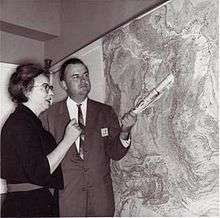Bruce C. Heezen
Bruce Charles Heezen (/ˈhiːzən/; April 11, 1924 – June 21, 1977) was an American geologist.[1] He worked with oceanographic cartographer Marie Tharp at Columbia University to map the Mid-Atlantic Ridge in the 1950s.
Bruce Charles Heezen | |
|---|---|
 Marie Tharp and Bruce Heezen | |
| Born | April 11, 1924 |
| Died | June 21, 1977 (aged 53) |
| Nationality | United States |
| Citizenship | United States |
| Alma mater | University of Iowa Columbia University |
| Known for | Seafloor topography |
| Awards | Cullum Geographical Medal (1973) |
| Scientific career | |
| Fields | Geology, Oceanography |
| Institutions | Lamont-Doherty Earth Observatory |
Biography
Heezen was born in Vinton, Iowa. An only child, he moved at age six with his parents to Muscatine, Iowa, where he graduated from high school in 1942. He received his B.A. from the University of Iowa in 1947. He received his M.A. in 1952 and a Ph.D in 1957 from Columbia University.
Heezen collaborated extensively with cartographer Marie Tharp. He interpreted their joint work on the Mid-Atlantic ridge as supporting S. Warren Carey's Expanding Earth Theory, developed in the 1950s,[2] but under Tharp's influence "eventually gave up the idea of an expanding earth for a form of continental drift in the mid-1960s."[3] Tharp was Heezen's assistant while he was a graduate student and he gave her the task of drafting seafloor profiles.[4] When she showed Heezen that her plotting of the North Atlantic revealed a rift valley, Heezen called it "girl talk" and dismissed it.[5] She persisted and they eventually discovered that not only was there a North Atlantic rift valley, but a mountain range with a central valley that spanned the earth.[5] They also realized that the oceanic earthquakes they had been separately plotting fell within the rift, a revolutionary theory at the time.[4] He presented this mid-ocean rift and earthquake theory at Princeton in 1957.[5] At that lecture, preeminent geologist Harry Hess[6] told Heezen, "Young man, you have shaken the foundations of geology!"[4][5]
Heezen died of a heart attack in 1977 while on a research cruise to study the Mid-Atlantic Ridge near Iceland aboard the NR-1 submarine.[7]
Honors and awards
- 1964: Henry Bryant Bigelow Medal in Oceanography awarded by the Woods Hole Oceanographic Institution [8]
- 1973: Cullum Geographical Medal awarded by the American Geographical Society [9]
The Oceanographic Survey Ship USNS Bruce C. Heezen was christened in honor of him in 1999.[10]
Heezen Glacier in Antarctica was named after him in 1977.[11]
References
- "Bruce C. Heezen". Physics Today. 30 (11): 77. November 1977. doi:10.1063/1.3037805. Archived from the original on 2013-09-28.
- Oreskes, Naomi, 2003, Plate Tectonics: An Insider's History Of The Modern Theory Of The Earth, Westview Press, p. 23, ISBN 0813341329
- Frankel, Henry, The Continental Drift Debate, Ch. 7 in Scientific controversies, p. 226, 1987, Cambridge University Press, ISBN 978-0-521-27560-6
- O'Connell, Suzanne (August 8, 2020). "Marie Tharp's maps revolutionized our knowledge of the seafloor". The Washington Post.
- Tharp, Marie (April 1, 1999). "Connect the Dots: Mapping the Seafloor and Discovering the Mid-ocean Ridge". Woods Hole Oceanographic Institute. Retrieved August 8, 2020.
- "Harry Hammond Hess | Encyclopedia.com". www.encyclopedia.com. Retrieved 2020-08-09.
- "Marie Tharp Bio". Woods Hole Oceanographic Institution. 2006-12-12. Archived from the original on 2007-01-08. Retrieved 2008-06-02.
- "Award recipients". Woods Hole Oceanographic Institution. Retrieved 7 April 2017.
- "The Cullum Geographical Medal". American Geographical Society. Archived from the original on 9 September 2015. Retrieved 7 April 2017.
- "Navy's Newest Ocean Survey Ship Will Offer Public Tours August 3 for Lamont Community August 4 & 5 at Intrepid Pier". The Earth Institute. 2000-07-14. Archived from the original on 2008-10-12. Retrieved 2008-06-02.
- "Antarctica Detail". geonames.usgs.gov. Retrieved 2020-08-09.
External links
- Bruce Heezen explaining formation of oil traps on the ocean floor on YouTube
- Bruce Heezen explaining turbidity currents on YouTube
- Manuscript painting of Heezen-Tharp "World ocean floor" map by Berann — Library of Congress Catalog